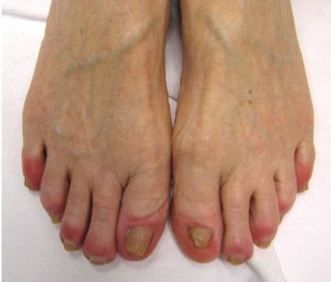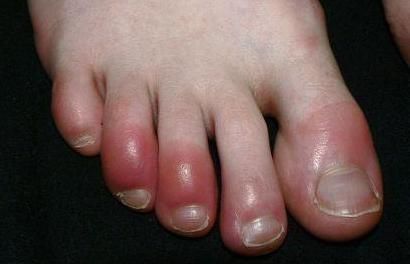- Clinical Technology
- Adult Immunization
- Hepatology
- Pediatric Immunization
- Screening
- Psychiatry
- Allergy
- Women's Health
- Cardiology
- Pediatrics
- Dermatology
- Endocrinology
- Pain Management
- Gastroenterology
- Infectious Disease
- Obesity Medicine
- Rheumatology
- Nephrology
- Neurology
- Pulmonology
Chilblains (Pernio)
Chilblains (Pernio) is typically caused by an abnormal vascular response to non-freezing cold exposure.


A 22-year-old woman presents with complaints of severe pain in all the toes on both feet. She reported going hiking and camping with some friends over the weekend. The daytime temperature during the trip had unexpectedly dropped as low as 4.4°C (40°F). She admits she had only sneakers to hike in and her feet had gotten very cold and uncomfortable during the day while hiking but felt better when she warmed them by the fire at night.
The patient describes persistent pain and mild pruritus in her toes. Examination reveals moderate erythema of most of her toes with some trace edema. The skin is intact without lesions, blisters or ulcerations. The patient’s vital signs are normal and she has no contributory past medical or surgical history. She takes no medications and has no drug allergies.
• What is your diagnosis, at a glance?
• What is the cause of this condition?
• What is the treatment?
The diagnosis is Chillblains (Pernio), a condition typically caused by an abnormal vascular response to non-freezing, cold exposure and often confused with trenchfoot, frostnip, or frostbite. It is diagnosed on the basis of the history and clinical findings that include erythematous to violaceous acral lesions. Prevention and treatment of pernio are both best accomplished by keeping extremities warm and dry. Most cases are self-limitied and resolve within 1 to 3 weeks. Chronic pernio can be caused by multiple systemic diseases and can be prevented and treated with calcium channel blockers.
For more information:
1. Maroon, Michele S. Pernio. Medscape review article. http://emedicine.medscape.com/article/1087946-overview. Accessed November 4, 2013.
2. Parra SL, Wisco OJ. What is your diagnosis? Perniosis (chilblain). Cutis. 2009;84:27-29.
3. Jordaan HF. The diagnosis and management of perniosis (chilblains). SA Fam Pract. 2007;49:28-29.
Images courtesy of Wikipedia Commons.For more quizzes on a wide range of topics, visit QuizEM.org.
